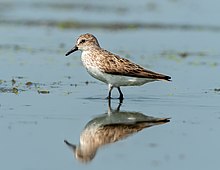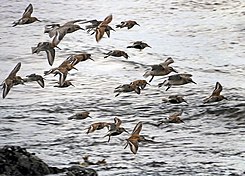Wader
| Waders Temporal range:
| |
|---|---|

| |
| Semipalmated sandpiper (Calidris pusilla) | |
| Scientific classification | |
| Domain: | Eukaryota |
| Kingdom: | Animalia |
| Phylum: | Chordata |
| Class: | Aves |
| Clade: | Neoaves |
| Order: | Charadriiformes |
| Groups included | |
| |
| Cladistically included but traditionally excluded taxa | |
| |

Waders or shorebirds are
There are about 210
Many of the smaller species found in
The smallest member of this group is the
Taxonomy
In the
The waders are traditionally a group of two Charadriiform
- Suborder (Eu)Charadrii
- Family Burhinidae– stone-curlews, thick-knees (10 species)
- Family Pluvianellidae– Magellanic plover
- Family Chionidae– sheathbills (2 species)
- Family Pluvianidae– Egyptian plover
- Family Charadriidae – plovers (68 species)
- Family Recurvirostridae – stilts, avocets (10 species)
- Family Ibidorhynchidae– ibisbill
- Family Haematopodidae– oystercatchers (12 species)
- Family
- Suborder Scolopaci
- Family Rostratulidae– painted-snipes (3 species)
- Family Jacanidae – jacanas (8 species)
- Family Pedionomidae– plains-wanderer
- Family Thinocoridae– seedsnipes (4 species)
- Family Scolopacidae– sandpipers, snipes (98 species)
- Family
- Suborder Lari
- Family Turnicidae– buttonquails (18 species)
- Family Dromadidae– crab-plover
- Family Glareolidae – coursers, pratincoles (17 species)
- Family
Characteristics
Shorebirds is a blanket term used to refer to multiple bird species that live in wet, coastal environments. Because most these species spend much of their time near bodies of water, many have long legs suitable for wading (hence the name 'Waders'). Some species prefer locations with rocks or mud. Many shorebirds display migratory patterns and often migrate before breeding season. These behaviors explain the long wing lengths observed in species, and can also account for the efficient metabolisms that give the birds energy during long migrations.[3]
The majority of species eat small
Sexual dimorphism
Shorebirds, like many other animals, exhibit phenotypic differences between males and females, also known as sexual dimorphism. In shorebirds, various sexual dimorphisms are seen, including, but not limited to, size (e.g. body size, bill size), color, and agility. In polygynous species, where one male individual mates with multiple female partners over his lifetime, dimorphisms tend to be more diverse.[3] In monogamous species, where male individuals mate with a single female partner, males typically do not have distinctive dimorphic characteristics such as colored feathers, but they still tend to be larger in size compared to females. The suborder Charadrii displays the widest range of sexual dimorphisms seen in the order Charadriiformes.[4] However, cases of sexual monomorphism, where there are no distinguishing physical features besides external genitalia, are also seen in this order.[5]
Sexual selection
One of the biggest factors that leads to the development of sexual dimorphism in shorebirds is sexual selection.[6] Males with ideal characteristics favored by females are more likely to reproduce and pass on their genetic information to their offspring better than the males who lack such characteristics. Mentioned earlier, male shorebirds are typically larger in size compared to their female counterparts. Competition between males tends to lead to sexual selection toward larger males and as a result, an increase in dimorphism. Bigger males tend to have greater access (and appeal) to female mates because their larger size aids them in defeating other competitors.[6] Likewise, if the species exhibits gender role reversal (where males take on roles traditionally done by females such as childcare and feeding), then males will select female mates based on traits that are the most appealing. In the Jacana species, females compete with each other for access to male mates, so females are larger in size. Males choose female mates based on who presents herself as the strongest and who 'owns' the most territory.[5]
Natural selection
Another factor that leads to the development of dimorphisms in species is natural selection. Natural selection focuses on traits and the environment's response to the traits in question; if the said trait increases the overall fitness of the individual possessing it, then it will be 'selected' and eventually become a permanent part of the population's gene pool. For example, depending on the food available in a shorebird specie's respective niche, bigger bill sizes may be favored in all individuals.[6] This would essentially lead to monomorphism within the species but is subject to change once sexual selection acts on the trait. Sexual selection could give rise to males with relatively larger bills than females if males used their bills to compete with other males. If larger bill size assisted the male in gathering resources, it would also make him more attractive to female mates.[3]
See also
References
- ^ G.C. Boere, C.A. Galbraith and D.A. Stroud (2006). "Waterbirds around the world" (PDF). Joint Nature Conservation Committee. Archived from the original (PDF) on 2014-06-16. Retrieved 2018-07-25.
- Rasmussen, Pamela, eds. (July 2021). "IOC World Bird List Version 11.2". International Ornithologists' Union. Retrieved 19 December 2021.
- ^ a b c "Explore the World With Shorebirds." U.S. Fish and Wildlife Service, 1 Aug. 2004. Web.http://www.fws.gov/alaska/external/education/pdf/Chap4.pdf .
- ^ Székely, Tamás, John D. Reynolds, and Jordi Figuerola. 2000. Sexual Size Dimorphism In Shorebirds, Gulls, And Alcids: The Influence Of Sexual And Natural Selection. 54(4): 1404-413. [1]
- ^ a b Lindenfors, P., T. Szekely, and J. D. Reynolds. "Directional Changes in Sexual Size Dimorphism in Shorebirds, Gulls and Alcids." Journal of Evolutionary Biology J. Evolution Biol: 930-38. Print.
- ^ a b c Szekely, T., R. P. Freckleton, and J. D. Reynolds. "Sexual Selection Explains Rensch's Rule of Size Dimorphism in Shorebirds." Proceedings of the National Academy of Sciences (2004): 12224-2227. Print.
Sources
- Ericson, P. G. P.; Envall, I.; Irestedt, M.; & Norman, J. A. (2003). Inter-familial relationships of the shorebirds (Aves: Charadriiformes) based on nuclear DNA sequence data.
- Pandiyan, J. and S. Asokan. 2015. Habitat use of pattern of tidal mud and sandflats by shorebirds (charadriiformes) Wintering in southern India. Coastal Conservation https://doi.org/10.1007/s11852-015-0413-9.
- Paton, Tara A.; & Baker, Allan J. (2006). Sequences from 14 mitochondrial genes provide a well-supported phylogeny of the Charadriiform birds congruent with the nuclear RAG-1 tree. Molecular Phylogenetics and Evolution 39(3): 657–667. PMID 16531074(HTML abstract)
- Paton, T. A.; Baker, A. J.; Groth, J. G.; & Barrowclough, G. F. (2003). RAG-1 sequences resolve phylogenetic relationships within charadriiform birds. Molecular Phylogenetics and Evolution 29: 268–278. PMID 13678682(HTML abstract)
- Thomas, Gavin H.; Wills, Matthew A. & Székely, Tamás (2004a). Phylogeny of shorebirds, gulls, and alcids (Aves: Charadrii) from the cytochrome-b gene: parsimony, Bayesian inference, minimum evolution, and quartet puzzling. Molecular Phylogenetics and Evolution 30(3): 516–526. (HTML abstract)
- Thomas, Gavin H.; Wills, Matthew A.; & Székely, Tamás (2004b). A supertree approach to shorebird phylogeny.
- van Tuinen, Marcel; Waterhouse, David; & Dyke, Gareth J. (2004). Avian molecular systematics on the rebound: a fresh look at modern shorebird phylogenetic relationships. Journal of Avian Biology 35(3): 191–194. PDF fulltext
- Explore the World With Shorebirds. (2004). U.S. Fish and Wildlife Service. Web. http://digitalmedia.fws.gov/cdm/ref/collection/document/id/1598
- Lindenfors, P.; Szekely, T.; and Reynolds, J. D. (2003). Directional Changes in Sexual Size Dimorphism in Shorebirds, Gulls and Alcids. Journal of Evolutionary Biology J Evolution Biol: 930–38. Print.
- Szekely, T.; Freckleton, R.; & Reynolds, J. (2004). Sexual selection explains Rensch's rule of size dimorphism in shorebirds. Proceedings of the National Academy of Sciences. 101(33): 12224–12227.
- Szekely, Tamas; John D. Reynolds; and Jordi Figuerola. (2000) Sexual Size Dimorphism in Shorebirds, Gulls, and Alcids: The Influence of Sexual and Natural Selection. Evolution 54(4): 1404–413.
External links
 Media related to Wading birds at Wikimedia Commons
Media related to Wading birds at Wikimedia Commons

